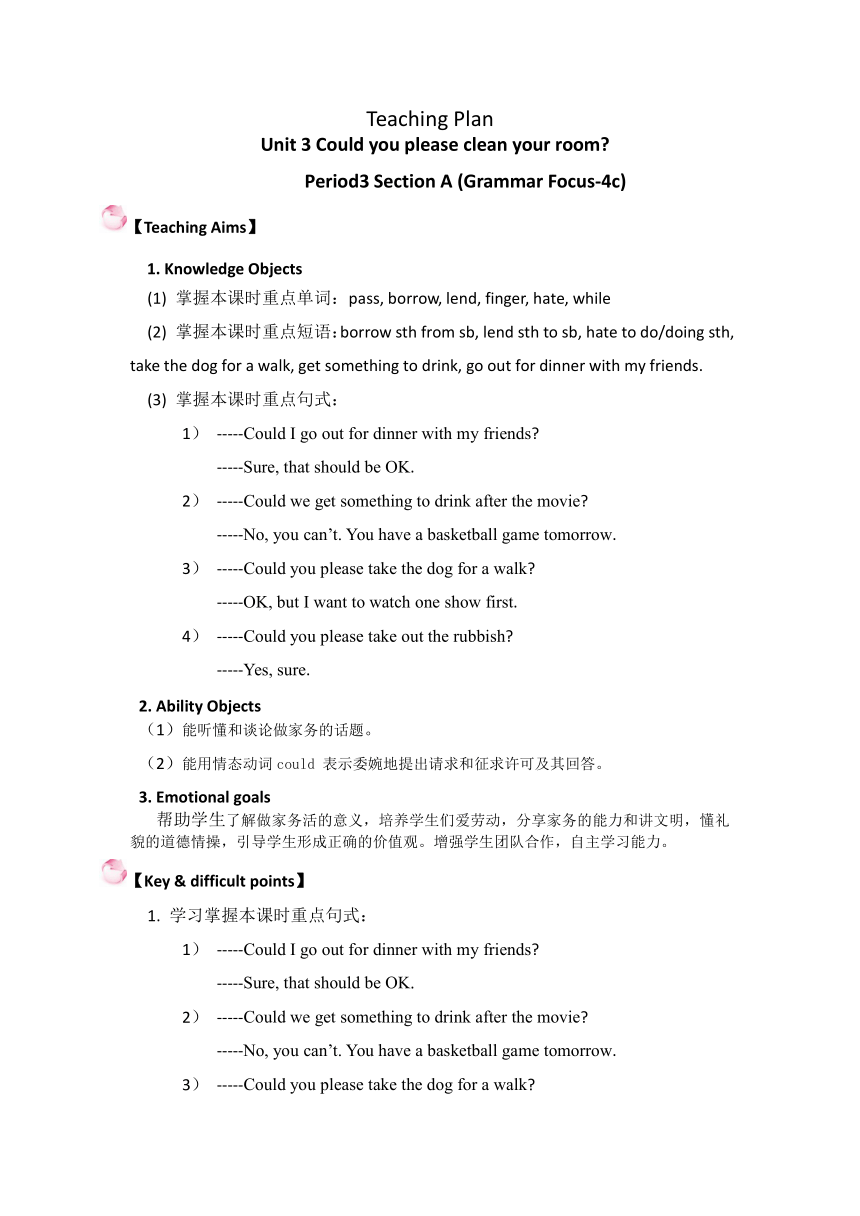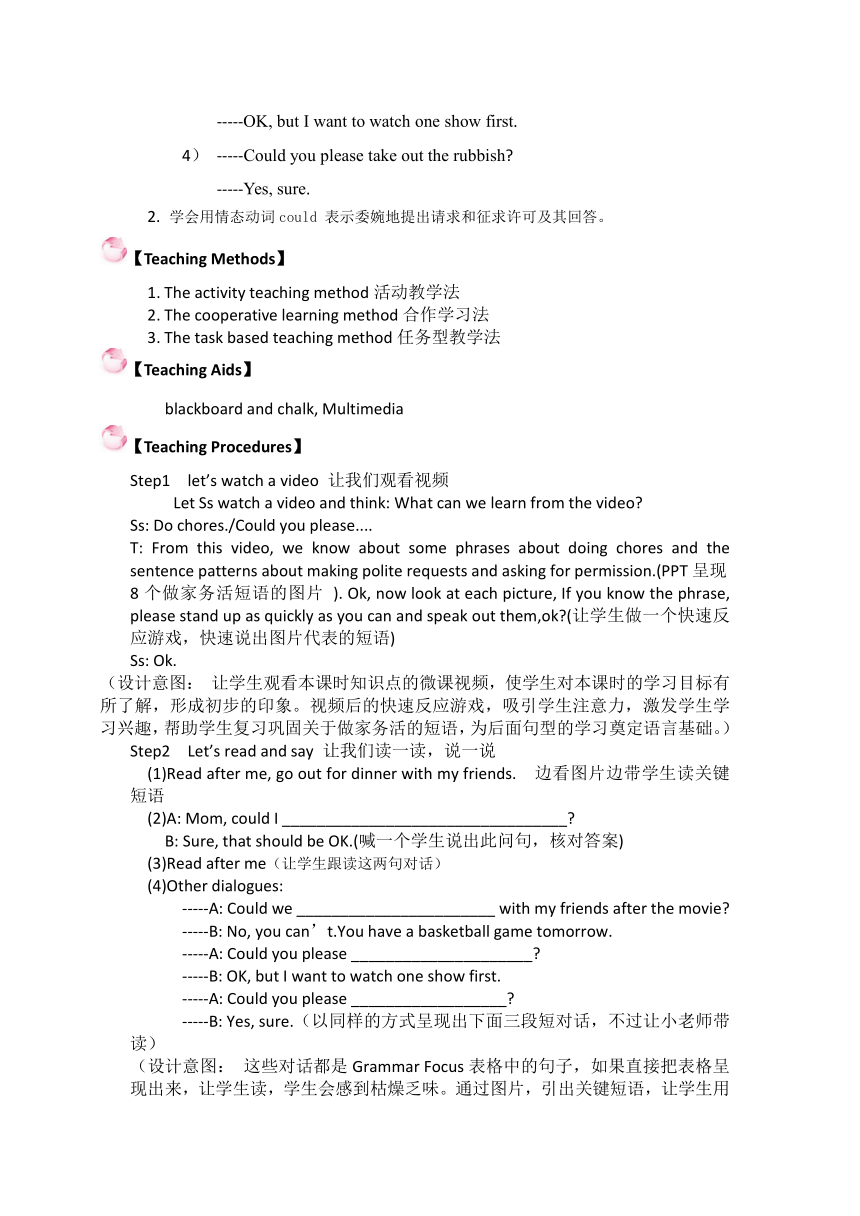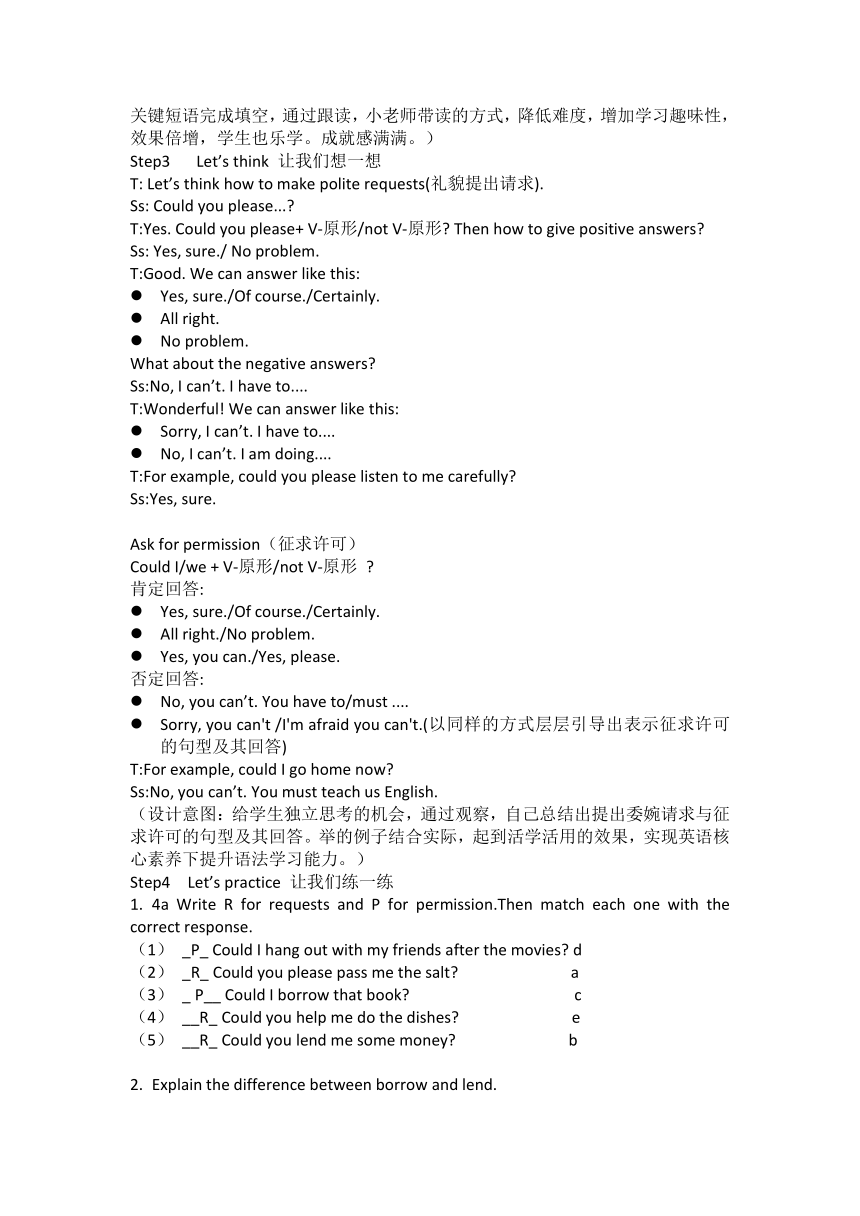Unit 3 Could you please clean your room?Section A (Grammar Focus-4c)(教案 )
文档属性
| 名称 | Unit 3 Could you please clean your room?Section A (Grammar Focus-4c)(教案 ) |  | |
| 格式 | doc | ||
| 文件大小 | 95.0KB | ||
| 资源类型 | 教案 | ||
| 版本资源 | 人教新目标(Go for it)版 | ||
| 科目 | 英语 | ||
| 更新时间 | 2022-03-23 17:35:32 | ||
图片预览



文档简介
Teaching Plan
Unit 3 Could you please clean your room
Period3 Section A (Grammar Focus-4c)
【Teaching Aims】
1. Knowledge Objects
(1) 掌握本课时重点单词:pass, borrow, lend, finger, hate, while
(2) 掌握本课时重点短语:borrow sth from sb, lend sth to sb, hate to do/doing sth, take the dog for a walk, get something to drink, go out for dinner with my friends.
(3) 掌握本课时重点句式:
1) -----Could I go out for dinner with my friends
-----Sure, that should be OK.
2) -----Could we get something to drink after the movie
-----No, you can’t. You have a basketball game tomorrow.
3) -----Could you please take the dog for a walk
-----OK, but I want to watch one show first.
4) -----Could you please take out the rubbish
-----Yes, sure.
2. Ability Objects
(1)能听懂和谈论做家务的话题。
(2)能用情态动词could 表示委婉地提出请求和征求许可及其回答。
3. Emotional goals
帮助学生了解做家务活的意义,培养学生们爱劳动,分享家务的能力和讲文明,懂礼貌的道德情操,引导学生形成正确的价值观。增强学生团队合作,自主学习能力。
【Key & difficult points】
1. 学习掌握本课时重点句式:
1) -----Could I go out for dinner with my friends
-----Sure, that should be OK.
2) -----Could we get something to drink after the movie
-----No, you can’t. You have a basketball game tomorrow.
3) -----Could you please take the dog for a walk
-----OK, but I want to watch one show first.
4) -----Could you please take out the rubbish
-----Yes, sure.
2. 学会用情态动词could 表示委婉地提出请求和征求许可及其回答。
【Teaching Methods】
1. The activity teaching method活动教学法
2. The cooperative learning method合作学习法
3. The task based teaching method任务型教学法
【Teaching Aids】
blackboard and chalk, Multimedia
【Teaching Procedures】
Step1 let’s watch a video 让我们观看视频
Let Ss watch a video and think: What can we learn from the video
Ss: Do chores./Could you please....
T: From this video, we know about some phrases about doing chores and the sentence patterns about making polite requests and asking for permission.(PPT呈现8个做家务活短语的图片 ). Ok, now look at each picture, If you know the phrase, please stand up as quickly as you can and speak out them,ok (让学生做一个快速反应游戏,快速说出图片代表的短语)
Ss: Ok.
(设计意图: 让学生观看本课时知识点的微课视频,使学生对本课时的学习目标有所了解,形成初步的印象。视频后的快速反应游戏,吸引学生注意力,激发学生学习兴趣,帮助学生复习巩固关于做家务活的短语,为后面句型的学习奠定语言基础。)
Step2 Let’s read and say 让我们读一读,说一说
(1)Read after me, go out for dinner with my friends. 边看图片边带学生读关键短语
(2)A: Mom, could I _________________________________
B: Sure, that should be OK.(喊一个学生说出此问句,核对答案)
(3)Read after me(让学生跟读这两句对话)
(4)Other dialogues:
-----A: Could we _______________________ with my friends after the movie
-----B: No, you can’t.You have a basketball game tomorrow.
-----A: Could you please _____________________
-----B: OK, but I want to watch one show first.
-----A: Could you please __________________
-----B: Yes, sure.(以同样的方式呈现出下面三段短对话,不过让小老师带读)
(设计意图: 这些对话都是Grammar Focus表格中的句子,如果直接把表格呈现出来,让学生读,学生会感到枯燥乏味。通过图片,引出关键短语,让学生用关键短语完成填空,通过跟读,小老师带读的方式,降低难度,增加学习趣味性,效果倍增,学生也乐学。成就感满满。)
Step3 Let’s think 让我们想一想
T: Let’s think how to make polite requests(礼貌提出请求).
Ss: Could you please...
T:Yes. Could you please+ V-原形/not V-原形 Then how to give positive answers
Ss: Yes, sure./ No problem.
T:Good. We can answer like this:
Yes, sure./Of course./Certainly.
All right.
No problem.
What about the negative answers
Ss:No, I can’t. I have to....
T:Wonderful! We can answer like this:
Sorry, I can’t. I have to....
No, I can’t. I am doing....
T:For example, could you please listen to me carefully
Ss:Yes, sure.
Ask for permission(征求许可)
Could I/we + V-原形/not V-原形
肯定回答:
Yes, sure./Of course./Certainly.
All right./No problem.
Yes, you can./Yes, please.
否定回答:
No, you can’t. You have to/must ....
Sorry, you can't /I'm afraid you can't.(以同样的方式层层引导出表示征求许可的句型及其回答)
T:For example, could I go home now
Ss:No, you can’t. You must teach us English.
(设计意图:给学生独立思考的机会,通过观察,自己总结出提出委婉请求与征求许可的句型及其回答。举的例子结合实际,起到活学活用的效果,实现英语核心素养下提升语法学习能力。)
Step4 Let’s practice 让我们练一练
1. 4a Write R for requests and P for permission.Then match each one with the correct response.
(1) _P_ Could I hang out with my friends after the movies d
(2) _R_ Could you please pass me the salt a
(3) _ P__ Could I borrow that book c
(4) __R_ Could you help me do the dishes e
(5) __R_ Could you lend me some money b
2. Explain the difference between borrow and lend.
3. Play a chain game and give out presents.
4. 4b Fill in the blanks in the conversation.
(设计意图: 给学生时间,让学生独立完成任务,然后喊两个学生分别核对答案。分男女角色对对话,进一步巩固提出委婉请求和征求许可的句型及其回答。在掌握重难点句型的同时,让学生理解近义词的辨析,并学会应用。接龙游戏的设计,加强学生小组团结合作竞争意识,帮助学生熟记目标语言。及时给予胜利组奖品,学生学习激情高涨,跃跃欲试。通过4b部分练习,帮助学生加强补全对话题型和逻辑思维能力训练。)
Step5 Let’s show(group work) 让我们演一演
1. 4c Make a list of things your group needs to do for a camping trip. Then discuss who will do them and complete the chart.
To—do list Name
Bring a tent Liu Chang
Buy some food Zhao Bo
2. What should we do before the trip
(bring a tent,take a big cloth,buy some drinks,buy some food,take a rubbish bag,bring a camera,get a knife,prepare some programs...)
A: Could you please bring a tent, Liu Chang
B: Sure. And could you please buy some food, Zhao Bo
C: Sorry, I can’t. I have to bring a camera.
D: Could I get a knife
E: Yes, you can.
3. Make your own conversations.
4. It’s the show time .
(设计意图: 在柔和的音乐伴奏中,组内合作讨论去野营需要准备的东西,分配到个人,列出表格。参考对话范例,编写自己的对话。提高学生听说读写能力,使学生学会灵活运用本课时目标句型。培养学生团队合作精神,创新意识。承诺课后给予表现精彩的小组颁发奖励,把课堂推向高潮。)
Step6 Let’s enjoy an ad 让我们一起欣赏公益广告
1. An ad about family
2. Emotional education.
Read the sentences together: Housework is not a waste of time. We should share the housework with our parents to have a clean and comfortable home.
(设计意图: 让学生观看family公益广告视频,让学生理解明白family这个单词每个字母所代表的含义,让学生学会感恩,理解父母的不易,体会父母的操劳,明白做家务活不是浪费时间,学会分享家务,才能创造一个干净舒适的家园。培养学生懂礼貌,讲文明的道德情操。)
Step7 Summary 总结
The teacher helps Ss summarize what they have learned this class.
Homework:
这个暑假你与父母要去法国去度假, 你的宠物小猫Mimi需要请Jimmy帮忙照顾。请用下面的提示词给Jimmy写封信。
take care of, take for a walk, feed and give some water, play with him, clean
Dear Jimmy, _____________________________________________________________________________________________________________________.
Li Ming
【Blackboard Design】
Unit 5 Could you please clean your room
Period3 Section A (Grammar Focus-4c)
Key words: Key phrases:
pass, borrow, lend, finger, hate, while borrow sth from sb, lend sth to sb, hate to do/doing sth, take the dog for a walk, get something to drink, go out for dinner with my friends.
Key sentences patterns:
★Ask for permission(征求许可)
Could you please+ V-原形/not V-原形
教学反思
通过本课时的学习,要求学生掌握重点单词,重点短语和重点句式,例如: finger, hate, while, borrow sth from sb, lend sth to sb, Could I go out for dinner with my friends Could you please take the dog for a walk 等;能听懂和谈论做家务的话题并能用情态动词could 表示委婉地提出请求和征求许可及其回答;帮助学生了解做家务活的意义,培养学生们爱劳动,分享家务的能力和讲文明,懂礼貌的道德情操,引导学生形成正确的价值观。增强学生团队合作,自主学习能力。
为达到教学目的,我首先让学生观看本课时知识点的微课视频,使学生对本课时的学习目标有所了解,形成初步的印象。视频后的快速反应游戏,吸引学生注意力,激发学生学习兴趣,帮助学生复习巩固关于做家务活的短语,为后面句型的学习奠定语言基础。在读一读,说一说环节,PPT展示的对话都是Grammar Focus表格中的句子,如果直接把表格呈现出来,让学生读,学生会感到枯燥乏味。通过图片,引出关键短语,让学生用关键短语完成填空,通过跟读,小老师带读的方式,降低难度,增加学习趣味性,效果倍增,学生也乐学。成就感满满。句子熟悉后,给学生独立思考的机会,通过观察,自己总结出提出委婉请求与征求许可的句型及其回答。举的例子结合实际,起到活学活用的效果,实现英语学科核心素养下提升语法学习能力。在练一练环节,教师趁热打铁,给学生时间,让学生独立完成任务,然后喊两个学生分别核对答案。分男女角色对对话,进一步巩固提出委婉请求和征求许可的句型及其回答。在掌握重难点句型的同时,让学生理解近义词的辨析,并学会应用。接龙游戏的设计,加强学生小组团结合作竞争意识,帮助学生熟记目标语言。及时给予胜利组奖品,学生学习激情高涨,跃跃欲试。通过4b部分练习,帮助学生加强补全对话题型和逻辑思维能力训练。紧接着,在柔和的音乐伴奏中,组内合作讨论去野营需要准备的东西,分配到个人,列出表格。参考对话范例,编写自己的对话。提高学生听说读写能力,使学生学会灵活运用本课时目标句型。培养学生团队合作精神,创新意识。承诺课后给予表现精彩的小组颁发奖励,把课堂推向高潮。最后,让学生观看family公益广告视频,让学生理解明白family这个单词每个字母所代表的含义,让学生学会感恩,理解父母的不易,体会父母的操劳,明白做家务活不是浪费时间,学会分享家务,才能创造一个干净舒适的家园。培养学生懂礼貌,讲文明的道德情操。课后作业的设计将课堂延伸到课外。
纵观本堂课,亮点有:
1、教学设计循序渐进,环环相扣,层层深入
2、教学手段多样化,新颖化,尤其是相关微课的利用,给学生传授新知
3、活动开展趣味化,真正实现学中乐,乐中学
4、基于新课程理念,注重学生英语学科核心素养能力的培养
本堂课教学目标明确,重难点突出,课堂气氛活跃,实现了以学生为主体,以教师为辅导,实现师生互动,生生互动的教学模式。但在一些细节处理上还不够完善,例如,学生独立思考或小组讨论的时间可留稍多点,充分调动他们的主观能动性,提升思维品质。另外,在小组活动后可设计个砸金蛋游戏,实现当堂奖励,效果会更佳。
Yes, sure./Of course./Certainly.
All right.
No problem.
肯定回答
No, you can’t. You have to/must ….
Sorry, you can't /I'm afraid you can't.
Yes, sure./Of course./Certainly.
All right./No problem.
Yes, you can./Yes, please.
否定回答
肯定回答
★Ask for permission(征求许可)
Sorry, I can’t. I have to ….
No, I can’t. I am doing….
否定回答
Unit 3 Could you please clean your room
Period3 Section A (Grammar Focus-4c)
【Teaching Aims】
1. Knowledge Objects
(1) 掌握本课时重点单词:pass, borrow, lend, finger, hate, while
(2) 掌握本课时重点短语:borrow sth from sb, lend sth to sb, hate to do/doing sth, take the dog for a walk, get something to drink, go out for dinner with my friends.
(3) 掌握本课时重点句式:
1) -----Could I go out for dinner with my friends
-----Sure, that should be OK.
2) -----Could we get something to drink after the movie
-----No, you can’t. You have a basketball game tomorrow.
3) -----Could you please take the dog for a walk
-----OK, but I want to watch one show first.
4) -----Could you please take out the rubbish
-----Yes, sure.
2. Ability Objects
(1)能听懂和谈论做家务的话题。
(2)能用情态动词could 表示委婉地提出请求和征求许可及其回答。
3. Emotional goals
帮助学生了解做家务活的意义,培养学生们爱劳动,分享家务的能力和讲文明,懂礼貌的道德情操,引导学生形成正确的价值观。增强学生团队合作,自主学习能力。
【Key & difficult points】
1. 学习掌握本课时重点句式:
1) -----Could I go out for dinner with my friends
-----Sure, that should be OK.
2) -----Could we get something to drink after the movie
-----No, you can’t. You have a basketball game tomorrow.
3) -----Could you please take the dog for a walk
-----OK, but I want to watch one show first.
4) -----Could you please take out the rubbish
-----Yes, sure.
2. 学会用情态动词could 表示委婉地提出请求和征求许可及其回答。
【Teaching Methods】
1. The activity teaching method活动教学法
2. The cooperative learning method合作学习法
3. The task based teaching method任务型教学法
【Teaching Aids】
blackboard and chalk, Multimedia
【Teaching Procedures】
Step1 let’s watch a video 让我们观看视频
Let Ss watch a video and think: What can we learn from the video
Ss: Do chores./Could you please....
T: From this video, we know about some phrases about doing chores and the sentence patterns about making polite requests and asking for permission.(PPT呈现8个做家务活短语的图片 ). Ok, now look at each picture, If you know the phrase, please stand up as quickly as you can and speak out them,ok (让学生做一个快速反应游戏,快速说出图片代表的短语)
Ss: Ok.
(设计意图: 让学生观看本课时知识点的微课视频,使学生对本课时的学习目标有所了解,形成初步的印象。视频后的快速反应游戏,吸引学生注意力,激发学生学习兴趣,帮助学生复习巩固关于做家务活的短语,为后面句型的学习奠定语言基础。)
Step2 Let’s read and say 让我们读一读,说一说
(1)Read after me, go out for dinner with my friends. 边看图片边带学生读关键短语
(2)A: Mom, could I _________________________________
B: Sure, that should be OK.(喊一个学生说出此问句,核对答案)
(3)Read after me(让学生跟读这两句对话)
(4)Other dialogues:
-----A: Could we _______________________ with my friends after the movie
-----B: No, you can’t.You have a basketball game tomorrow.
-----A: Could you please _____________________
-----B: OK, but I want to watch one show first.
-----A: Could you please __________________
-----B: Yes, sure.(以同样的方式呈现出下面三段短对话,不过让小老师带读)
(设计意图: 这些对话都是Grammar Focus表格中的句子,如果直接把表格呈现出来,让学生读,学生会感到枯燥乏味。通过图片,引出关键短语,让学生用关键短语完成填空,通过跟读,小老师带读的方式,降低难度,增加学习趣味性,效果倍增,学生也乐学。成就感满满。)
Step3 Let’s think 让我们想一想
T: Let’s think how to make polite requests(礼貌提出请求).
Ss: Could you please...
T:Yes. Could you please+ V-原形/not V-原形 Then how to give positive answers
Ss: Yes, sure./ No problem.
T:Good. We can answer like this:
Yes, sure./Of course./Certainly.
All right.
No problem.
What about the negative answers
Ss:No, I can’t. I have to....
T:Wonderful! We can answer like this:
Sorry, I can’t. I have to....
No, I can’t. I am doing....
T:For example, could you please listen to me carefully
Ss:Yes, sure.
Ask for permission(征求许可)
Could I/we + V-原形/not V-原形
肯定回答:
Yes, sure./Of course./Certainly.
All right./No problem.
Yes, you can./Yes, please.
否定回答:
No, you can’t. You have to/must ....
Sorry, you can't /I'm afraid you can't.(以同样的方式层层引导出表示征求许可的句型及其回答)
T:For example, could I go home now
Ss:No, you can’t. You must teach us English.
(设计意图:给学生独立思考的机会,通过观察,自己总结出提出委婉请求与征求许可的句型及其回答。举的例子结合实际,起到活学活用的效果,实现英语核心素养下提升语法学习能力。)
Step4 Let’s practice 让我们练一练
1. 4a Write R for requests and P for permission.Then match each one with the correct response.
(1) _P_ Could I hang out with my friends after the movies d
(2) _R_ Could you please pass me the salt a
(3) _ P__ Could I borrow that book c
(4) __R_ Could you help me do the dishes e
(5) __R_ Could you lend me some money b
2. Explain the difference between borrow and lend.
3. Play a chain game and give out presents.
4. 4b Fill in the blanks in the conversation.
(设计意图: 给学生时间,让学生独立完成任务,然后喊两个学生分别核对答案。分男女角色对对话,进一步巩固提出委婉请求和征求许可的句型及其回答。在掌握重难点句型的同时,让学生理解近义词的辨析,并学会应用。接龙游戏的设计,加强学生小组团结合作竞争意识,帮助学生熟记目标语言。及时给予胜利组奖品,学生学习激情高涨,跃跃欲试。通过4b部分练习,帮助学生加强补全对话题型和逻辑思维能力训练。)
Step5 Let’s show(group work) 让我们演一演
1. 4c Make a list of things your group needs to do for a camping trip. Then discuss who will do them and complete the chart.
To—do list Name
Bring a tent Liu Chang
Buy some food Zhao Bo
2. What should we do before the trip
(bring a tent,take a big cloth,buy some drinks,buy some food,take a rubbish bag,bring a camera,get a knife,prepare some programs...)
A: Could you please bring a tent, Liu Chang
B: Sure. And could you please buy some food, Zhao Bo
C: Sorry, I can’t. I have to bring a camera.
D: Could I get a knife
E: Yes, you can.
3. Make your own conversations.
4. It’s the show time .
(设计意图: 在柔和的音乐伴奏中,组内合作讨论去野营需要准备的东西,分配到个人,列出表格。参考对话范例,编写自己的对话。提高学生听说读写能力,使学生学会灵活运用本课时目标句型。培养学生团队合作精神,创新意识。承诺课后给予表现精彩的小组颁发奖励,把课堂推向高潮。)
Step6 Let’s enjoy an ad 让我们一起欣赏公益广告
1. An ad about family
2. Emotional education.
Read the sentences together: Housework is not a waste of time. We should share the housework with our parents to have a clean and comfortable home.
(设计意图: 让学生观看family公益广告视频,让学生理解明白family这个单词每个字母所代表的含义,让学生学会感恩,理解父母的不易,体会父母的操劳,明白做家务活不是浪费时间,学会分享家务,才能创造一个干净舒适的家园。培养学生懂礼貌,讲文明的道德情操。)
Step7 Summary 总结
The teacher helps Ss summarize what they have learned this class.
Homework:
这个暑假你与父母要去法国去度假, 你的宠物小猫Mimi需要请Jimmy帮忙照顾。请用下面的提示词给Jimmy写封信。
take care of, take for a walk, feed and give some water, play with him, clean
Dear Jimmy, _____________________________________________________________________________________________________________________.
Li Ming
【Blackboard Design】
Unit 5 Could you please clean your room
Period3 Section A (Grammar Focus-4c)
Key words: Key phrases:
pass, borrow, lend, finger, hate, while borrow sth from sb, lend sth to sb, hate to do/doing sth, take the dog for a walk, get something to drink, go out for dinner with my friends.
Key sentences patterns:
★Ask for permission(征求许可)
Could you please+ V-原形/not V-原形
教学反思
通过本课时的学习,要求学生掌握重点单词,重点短语和重点句式,例如: finger, hate, while, borrow sth from sb, lend sth to sb, Could I go out for dinner with my friends Could you please take the dog for a walk 等;能听懂和谈论做家务的话题并能用情态动词could 表示委婉地提出请求和征求许可及其回答;帮助学生了解做家务活的意义,培养学生们爱劳动,分享家务的能力和讲文明,懂礼貌的道德情操,引导学生形成正确的价值观。增强学生团队合作,自主学习能力。
为达到教学目的,我首先让学生观看本课时知识点的微课视频,使学生对本课时的学习目标有所了解,形成初步的印象。视频后的快速反应游戏,吸引学生注意力,激发学生学习兴趣,帮助学生复习巩固关于做家务活的短语,为后面句型的学习奠定语言基础。在读一读,说一说环节,PPT展示的对话都是Grammar Focus表格中的句子,如果直接把表格呈现出来,让学生读,学生会感到枯燥乏味。通过图片,引出关键短语,让学生用关键短语完成填空,通过跟读,小老师带读的方式,降低难度,增加学习趣味性,效果倍增,学生也乐学。成就感满满。句子熟悉后,给学生独立思考的机会,通过观察,自己总结出提出委婉请求与征求许可的句型及其回答。举的例子结合实际,起到活学活用的效果,实现英语学科核心素养下提升语法学习能力。在练一练环节,教师趁热打铁,给学生时间,让学生独立完成任务,然后喊两个学生分别核对答案。分男女角色对对话,进一步巩固提出委婉请求和征求许可的句型及其回答。在掌握重难点句型的同时,让学生理解近义词的辨析,并学会应用。接龙游戏的设计,加强学生小组团结合作竞争意识,帮助学生熟记目标语言。及时给予胜利组奖品,学生学习激情高涨,跃跃欲试。通过4b部分练习,帮助学生加强补全对话题型和逻辑思维能力训练。紧接着,在柔和的音乐伴奏中,组内合作讨论去野营需要准备的东西,分配到个人,列出表格。参考对话范例,编写自己的对话。提高学生听说读写能力,使学生学会灵活运用本课时目标句型。培养学生团队合作精神,创新意识。承诺课后给予表现精彩的小组颁发奖励,把课堂推向高潮。最后,让学生观看family公益广告视频,让学生理解明白family这个单词每个字母所代表的含义,让学生学会感恩,理解父母的不易,体会父母的操劳,明白做家务活不是浪费时间,学会分享家务,才能创造一个干净舒适的家园。培养学生懂礼貌,讲文明的道德情操。课后作业的设计将课堂延伸到课外。
纵观本堂课,亮点有:
1、教学设计循序渐进,环环相扣,层层深入
2、教学手段多样化,新颖化,尤其是相关微课的利用,给学生传授新知
3、活动开展趣味化,真正实现学中乐,乐中学
4、基于新课程理念,注重学生英语学科核心素养能力的培养
本堂课教学目标明确,重难点突出,课堂气氛活跃,实现了以学生为主体,以教师为辅导,实现师生互动,生生互动的教学模式。但在一些细节处理上还不够完善,例如,学生独立思考或小组讨论的时间可留稍多点,充分调动他们的主观能动性,提升思维品质。另外,在小组活动后可设计个砸金蛋游戏,实现当堂奖励,效果会更佳。
Yes, sure./Of course./Certainly.
All right.
No problem.
肯定回答
No, you can’t. You have to/must ….
Sorry, you can't /I'm afraid you can't.
Yes, sure./Of course./Certainly.
All right./No problem.
Yes, you can./Yes, please.
否定回答
肯定回答
★Ask for permission(征求许可)
Sorry, I can’t. I have to ….
No, I can’t. I am doing….
否定回答
同课章节目录
- Unit 1 What's the matter?
- Section A
- Section B
- Unit 2 I'll help to clean up the city parks.
- Section A
- Section B
- Unit 3 Could you please clean your room?
- Section A
- Section B
- Unit 4 Why don't you talk to your parents?
- Section A
- Section B
- Unit 5 What were you doing when the rainstorm came
- Section A
- Section B
- Review of Units 1-5
- Unit 6 An old man tried to move the mountains.
- Section A
- Section B
- Unit 7 What's the highest mountain in the world?
- Section A
- Section B
- Unit 8 Have you read Treasure Island yet?
- Section A
- Section B
- Unit 9 Have you ever been to a museum?
- Section A
- Section B
- Unit 10 I've had this bike for three years.
- Section A
- Section B
